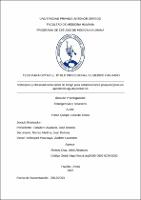Sobrepeso y obesidad como factor de riesgo para complicaciones posquirúrgicas en apendicitis aguda pediátrica
Abstract
Objetivo: Determinar si en pacientes pediátricos con apendicitis aguda el
sobrepeso-obesidad constituyen un factor de riesgo para una mayor tasa de
complicaciones posquirúrgicas que en aquellos con peso normal.
Métodos: Se dividieron a los pacientes en dos cohortes de 101 pacientes en
cada grupo: una con sobrepeso-obesidad y otra con normopeso, siguiendo
criterios de selección específicos. Se determinó el tamaño de muestra necesario
y se aplicaron pruebas estadísticas descriptivas y analíticas, como Chi Cuadrado
y prueba t de Student, para comparar las características clínicas y las
complicaciones entre los grupos. El estudio se realizó en el Hospital Regional
Docente de Trujillo durante el periodo comprendido entre enero del 2018 y junio
del 2023
Resultados: Se observaron diferencias significativas entre los grupos en cuanto
a la edad (9,11 ± 3,79 vs 10,94 ± 4,21 años; p = 0,001), el sexo masculino
(60,40% vs 45,54%; p = 0,034), el IMC (23,38 ± 3,49 vs 18,97 ± 2,77; p = 0,001)
y el tipo de apendicitis, siendo más complicadas en el grupo de sobrepeso obesidad (gangrenada: 32,67% vs 19,80% y perforada: 43,57% vs 36,63%; p =
0,008). Se encontraron asociaciones significativas entre el sobrepeso-obesidad
y la aparición de complicaciones postoperatorias de manera global (29,70% vs
16,83%; RR = 1,39, IC 95% [1,06-1,83], p = 0,030), y de manera específica el
íleo postoperatorio (19,80% vs 4,95%; RR = 1,75, IC 95% [1,36-2,25], p = 0,001).
No se observaron diferencias significativas en otras complicaciones como la
infección del sitio operatorio o la presencia de absceso intraabdominal.
Conclusión: Este estudio sugiere que el sobrepeso-obesidad en pacientes
pediátricos con apendicitis aguda se asocia significativamente con un mayor
riesgo de complicaciones postoperatorias, especialmente el íleo postoperatorio Objective: To determine whether overweight-obesity in pediatric patients with
acute appendicitis is a risk factor for a higher rate of post-surgical complications
compared to those with normal weight.
Methods: Patients were divided into two cohorts, each consisting of 101 patients:
one with overweight-obesity and the other with normal weight, following specific
selection criteria. The required sample size was determined, and descriptive and
analytical statistical tests, such as Chi-square and Student's t-test, were applied
to compare clinical characteristics and complications between the groups. The
study was conducted at the Regional Teaching Hospital of Trujillo between
January 2018 and June 2023.
Results: Significant differences were observed between the groups in terms of
age (9.11 ± 3.79 vs. 10.94 ± 4.21 years; p = 0.001), male sex (60.40% vs.
45.54%; p = 0.034), BMI (23.38 ± 3.49 vs. 18.97 ± 2.77; p = 0.001), and the type
of appendicitis, with more complicated cases in the overweight-obesity group
(gangrenous: 32.67% vs. 19.80% and perforated: 43.57% vs. 36.63%; p = 0.008).
Significant associations were found between overweight-obesity and the
occurrence of postoperative complications overall (29.70% vs. 16.83%; RR =
1.39, 95% CI [1.06-1.83], p = 0.030), and specifically, postoperative ileus
(19.80% vs. 4.95%; RR = 1.75, 95% CI [1.36-2.25], p = 0.001). No significant
differences were observed in other complications such as surgical site infection
or the presence of intraabdominal abscess.
Conclusion: This study suggests that overweight-obesity in pediatric patients
with acute appendicitis is significantly associated with a higher risk of
postoperative complications, particularly postoperative ileus
Subject
Collections
- Medicina Humana [3196]


